Brief Overview
A horizontal line on a pregnancy test, instead of vertical, usually indicates a negative result, confirming the absence of pregnancy. This horizontal line serves as a control for ensuring the test’s functionality.
To obtain reliable results, thoroughly follow the test instructions and interpret the lines within the timeframe allowed. .
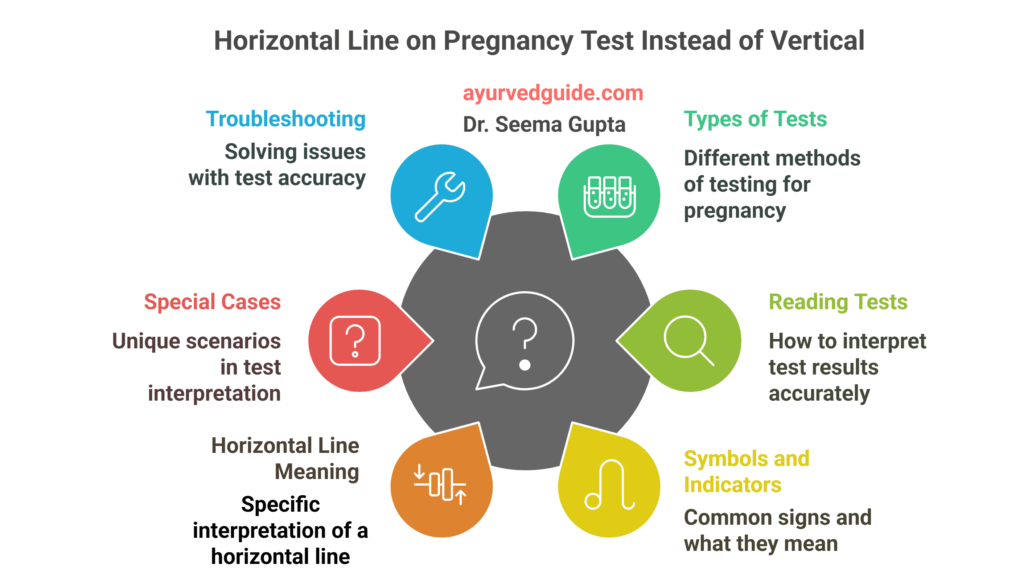
Pregnancy tests are supposed to show a clear result, but what does it mean if you see a Horizontal Line on Pregnancy Test Instead of Vertical? This surprising outcome can make you feel confused and worried, especially if you’re hoping for news about a possible baby or you have to avoid pregnancy for a strong reason.
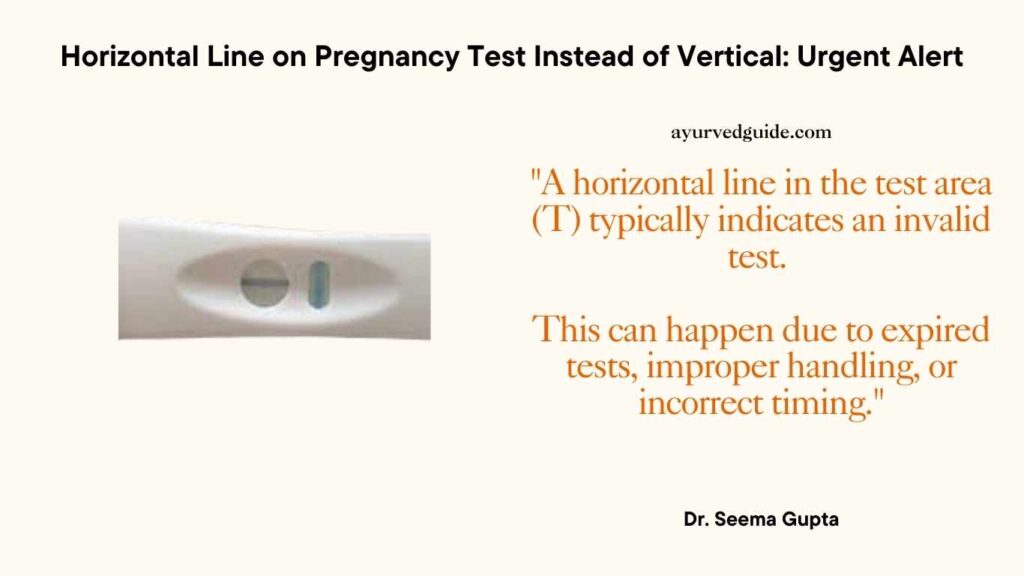
It’s important to understand what different test results mean for proper understanding. A horizontal line on a pregnancy test usually means the answer is negative, but there are some exceptions and things to keep in mind.
“Explore test result tips in our Women’s Health Guide.”
If you are trying to get pregnant or prevent pregnancy, understanding how to fix odd test results and make tests more accurate is very important.
So in this article, let’s understand in detail about Horizontal Line on Pregnancy Test Instead of Vertical and what to do next.
Understanding Pregnancy Test Result
Types of pregnancy tests
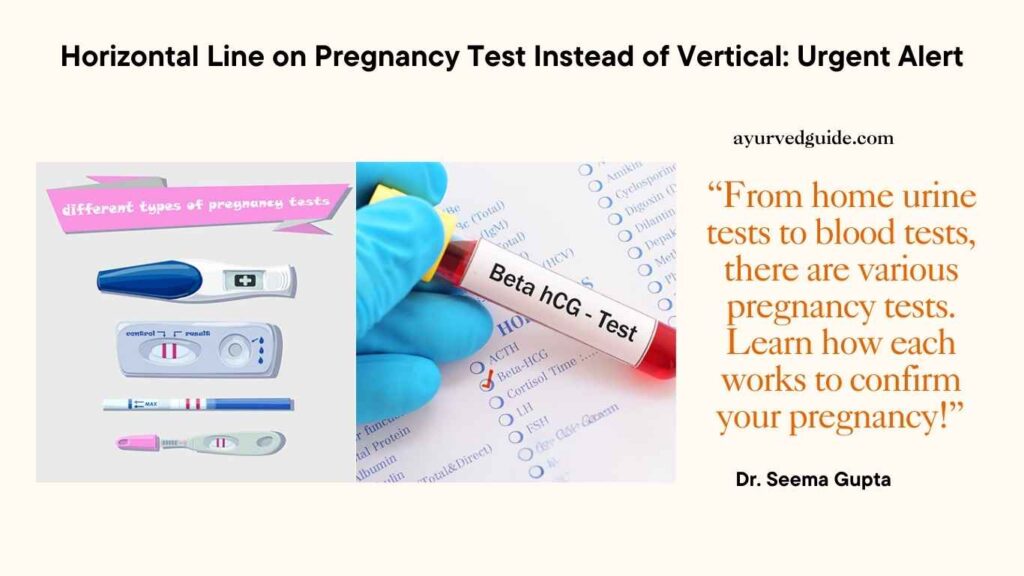
Pregnancy tests are essential tools for detecting pregnancy early. There are two main types:
Urine tests
- At-home tests
- Strip tests (single and two-window versions
- Digital tests
Blood tests
- Performed at healthcare provider’s office
- More sensitive and can detect pregnancy earlier
Urine tests are widely accessible and about 99% accurate when used correctly. Blood tests, while more sensitive, require a visit to a healthcare provider.
10 Reasons for Faint Line on Pregnancy Test
How to read a pregnancy test correctly
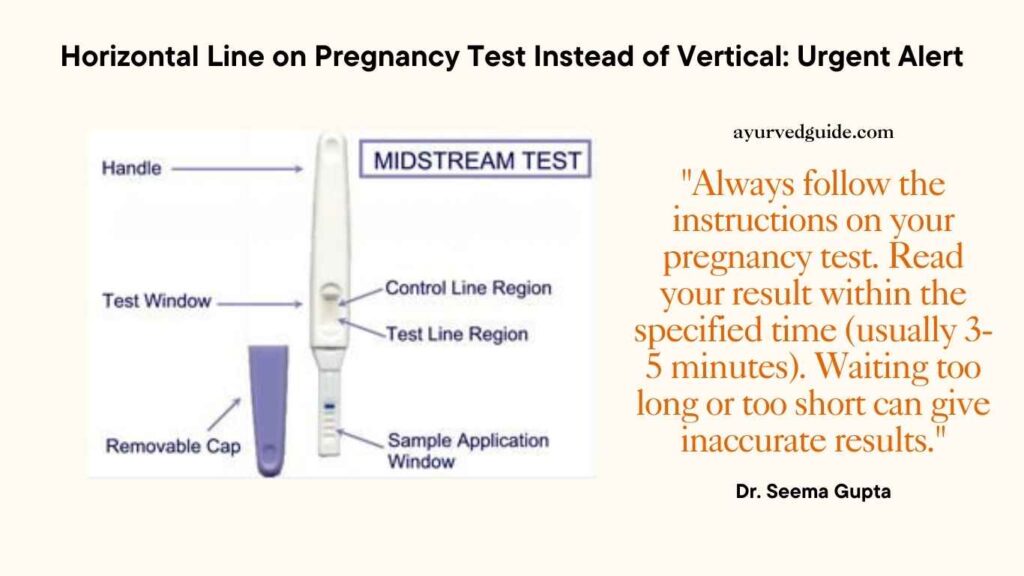
To ensure accurate results, follow these steps:
- Use first-morning urine for the highest hCG concentration
- Carefully follow instructions for sample collection and test timing
- Avoid overhydration, which can dilute hCG levels
- Wait at least one week after a missed period for more reliable results
- Place the test device flat for 5 minutes to process the results
| Test Type | Positive Result | Negative Result |
|---|---|---|
| Single-window | Two lines visible | Only the control line is visible |
| Two-window | Distinct color bands in both control and test regions | Only the control line is visible |
| Digital | “Pregnant” or similar message | “Not Pregnant” or similar message |
Common symbols and indicators
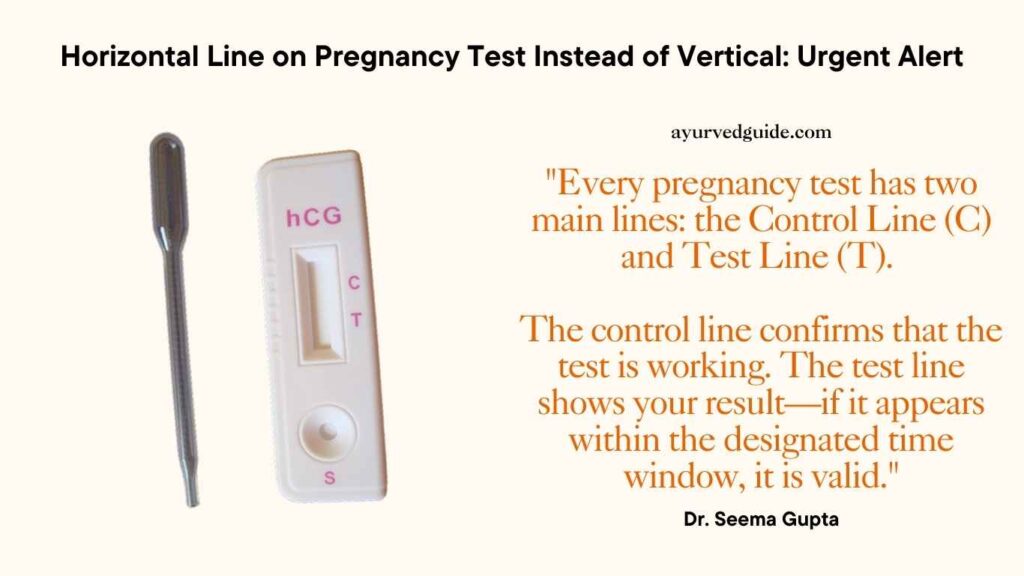
Understanding test indicators is crucial for proper interpretation:
- Control line: Confirms the test is working correctly
- Test line: Indicates pregnancy when visible
- Faint line: May indicate early pregnancy or reading past the recommended time
- No control line: Invalid result, retest required
It’s important to note that the test line may be less intense than the control line in positive results. If uncertain about the results, consult a healthcare provider for confirmation.
Horizontal Line on Pregnancy Test: What It Means
What Does a Horizontal Line Mean on a Pregnancy Test?
A horizontal line on a pregnancy test can be confusing, especially when most tests are designed to show vertical lines. The meaning of a horizontal line can vary depending on the brand and type of test used.
Explanation of a Horizontal Line Results
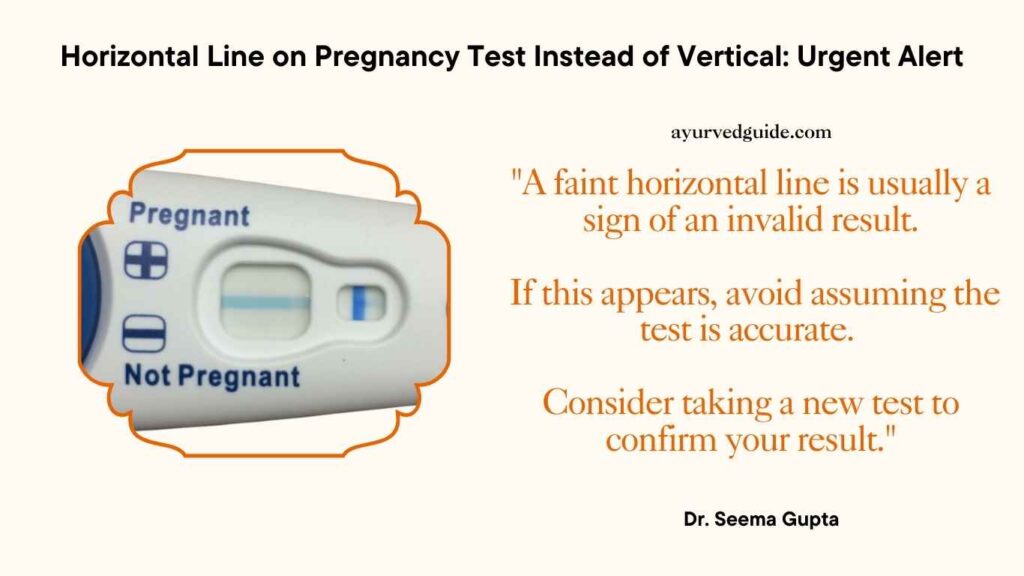
Usually, a horizontal line on a pregnancy test is not a standard result. It may indicate:
- An invalid test
- A manufacturing defect
- Improper test usage
- A very early positive result (in rare cases)
Possible Reasons for a Horizontal Line
| Reason | Explanation |
|---|---|
| Invalid Test | The test may not have been performed correctly or may have malfunctioned |
| Manufacturing Defect | Rarely, a test may have a production issue causing an unusual result |
| Improper Usage | Not following instructions precisely can lead to unexpected results |
| Early Positive | In some cases, a faint horizontal line might indicate a very early pregnancy |
Faint Horizontal Line on Pregnancy Test
A faint horizontal line can be particularly puzzling. It’s important to note that:
- Faint lines are often difficult to interpret
- They may be caused by evaporation lines
- In some cases, they could indicate a very early positive result
Distinguishing Between Evaporation Lines and Test Lines
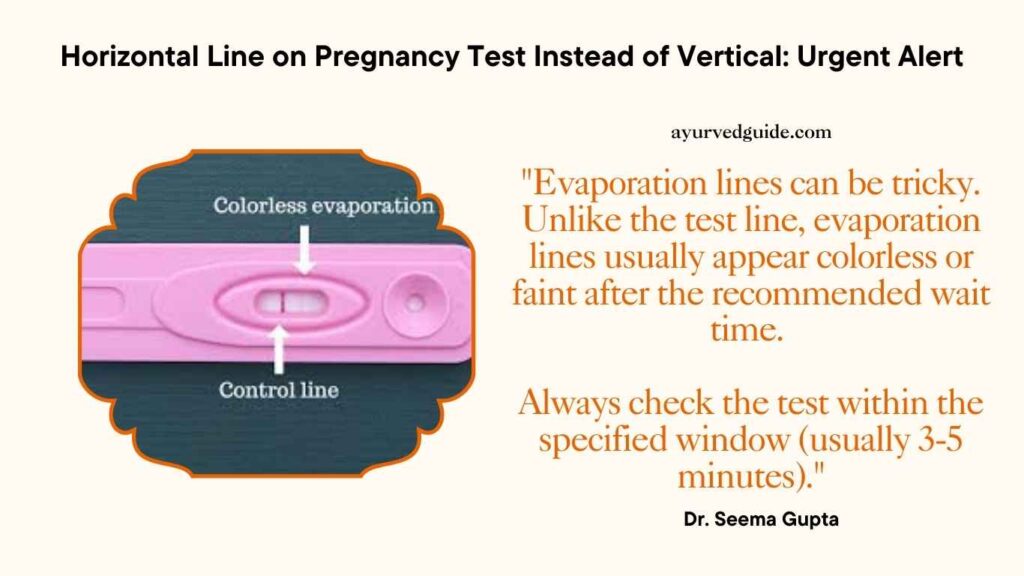
To differentiate between an evaporation line and a true test line:
- Check the test within the recommended time frame
- Observe the color of the line (evaporation lines are often colorless)
- Note the position of the line relative to where the test line should appear.
Validity of the Test Result – Horizontal Line on Pregnancy Test Instead of Vertical
A horizontal line instead of a vertical one often indicates an invalid test result. In such cases:
- The test should not be considered reliable
- A new test should be taken, following instructions carefully
- If uncertainty persists, consult with a healthcare provider
Pregnancy Test Line Sideways
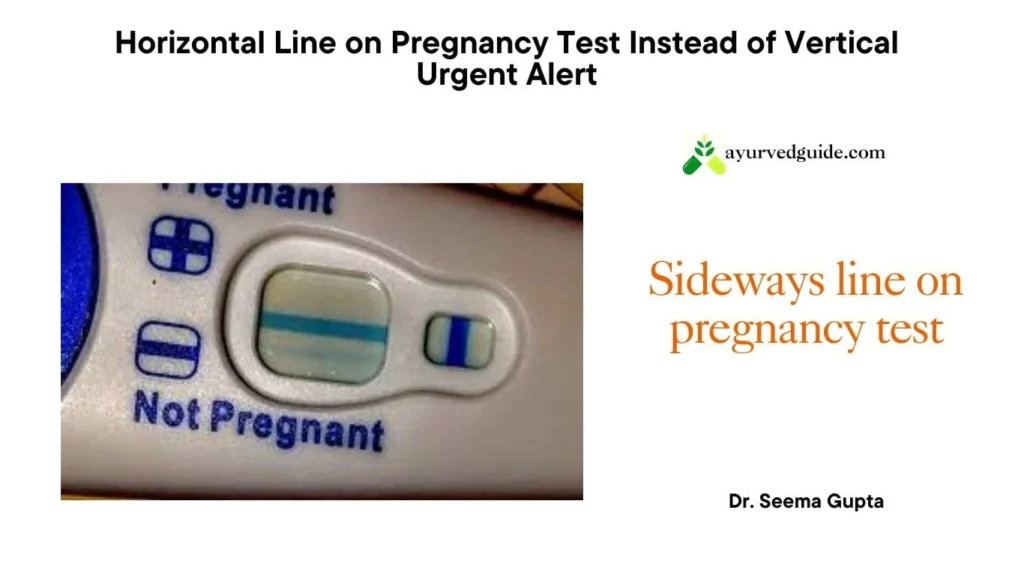
A sideways or horizontal line is not typically how pregnancy tests are designed to display results. This unusual orientation may suggest:
- The test was not used correctly
- There’s a problem with the test itself
- The result is invalid and should not be interpreted
Faint Horizontal Line and Dark Vertical Line on Pregnancy Test
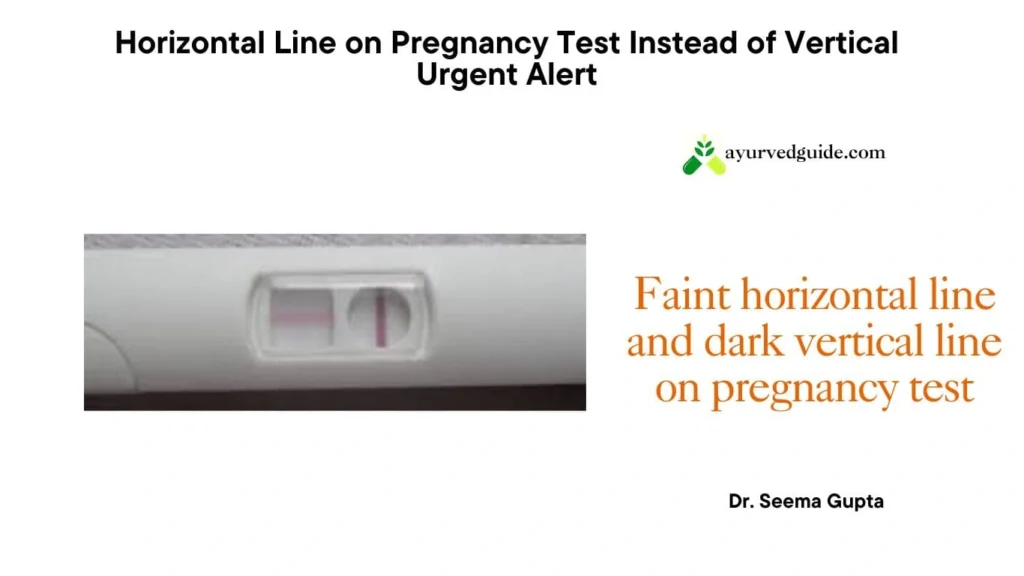
Users might sometimes observe a faint horizontal line and a dark vertical line. This combination could indicate:
- A positive result with an additional manufacturing issue
- An invalid test that should be retaken
- A need for further testing or professional consultation
Seeing a horizontal line on a pregnancy test instead of vertical can be confusing, but it’s crucial to understand whether it’s an evaporation line, a faulty test, or a real sign of pregnancy. To clear your doubts, compare it with the evaporation line vs faint positive guide to understand what’s really happening. If conception is suspected, look for early clues like the first 72 hours of pregnancy symptoms, and learn how to calculate your ovulation day for better planning in future cycles. Also, for those planning conception mindfully, Garbh Sanskar offers powerful Ayurvedic methods for maternal and fetal wellness.
Horizontal Line on Pregnancy Test Instead of Vertical: Special Cases
Pregnancy test horizontal line – Horizontal line pregnancy test – horizontal line in pregnancy test
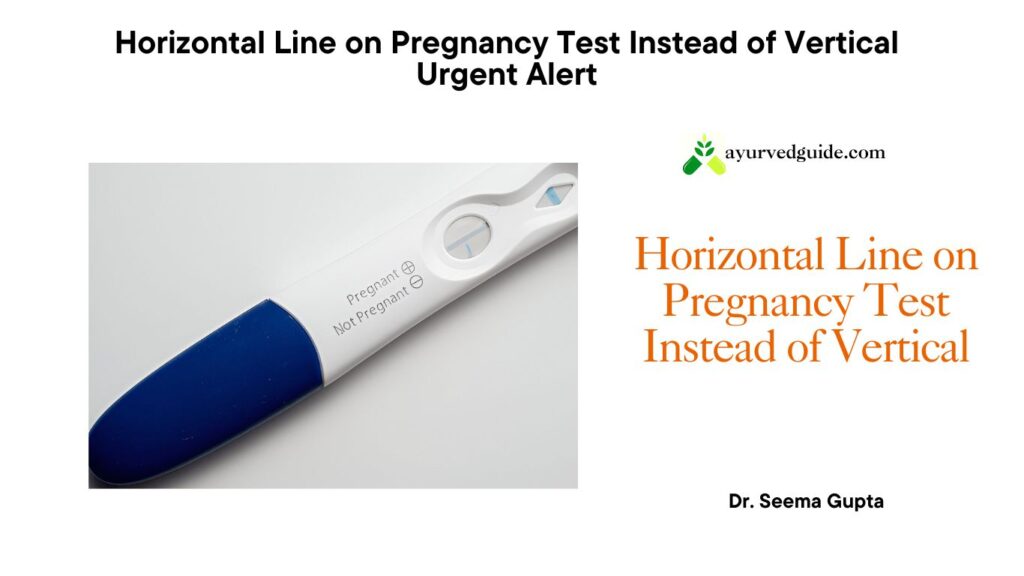
Horizontal Line on Pregnancy Test Instead of Vertical Twins
No scientific evidence suggests that a horizontal line instead of a vertical one indicates twins. Multiple pregnancies are typically confirmed through other medical tests.
Horizontal line in Prega News
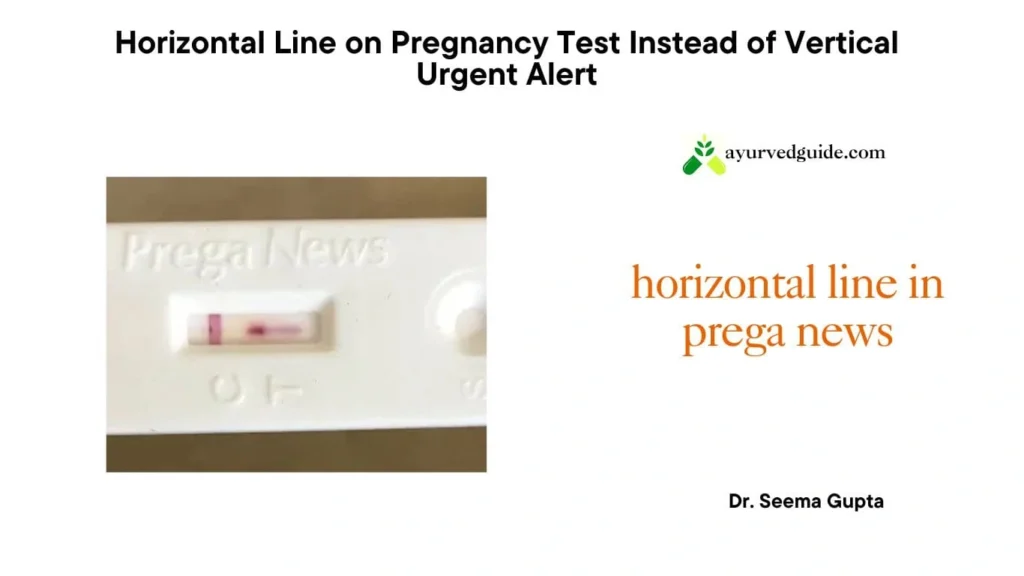
Horizontal Line on Pregnancy Test Instead of Vertical IVF
For those undergoing IVF, any unusual test results should be discussed with the fertility specialist. A horizontal line does not have a specific meaning for IVF pregnancies.
Horizontal Line on Pregnancy Test Instead of Vertical Clearblue
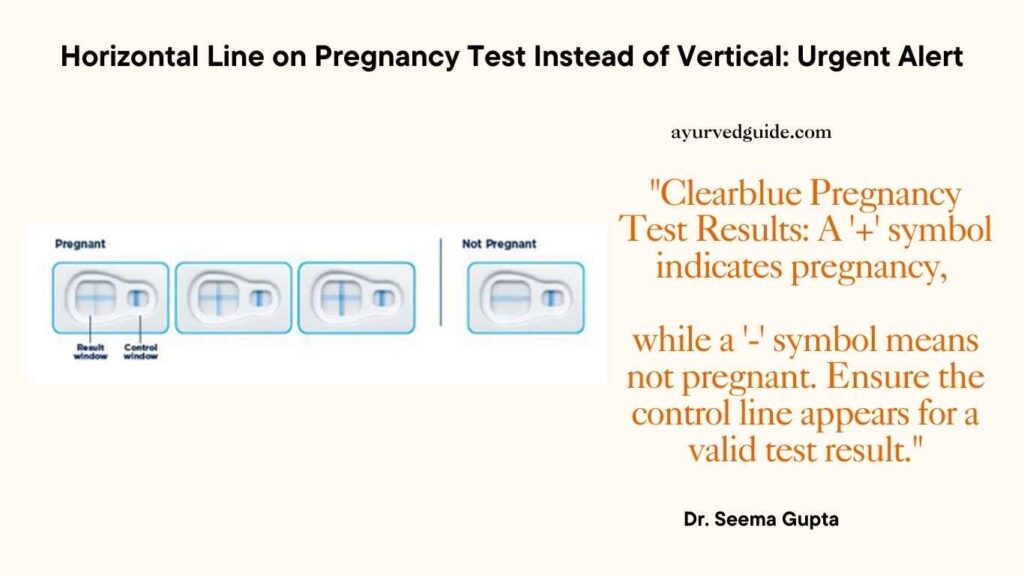
The Clearblue pregnancy test displays results in the form of a “+” (plus) or “-” (minus) symbol.
In the examples labeled “Pregnant,” the result window shows a clear “+” symbol, formed by a vertical line intersecting with a horizontal line. This indicates the presence of hCG hormone, confirming pregnancy.
In the “Not Pregnant” example, the result window shows a single horizontal line, forming a “-” (minus) symbol. This indicates no detectable hCG hormone and suggests that the individual is not pregnant.
Always ensure the control line in the smaller window appears. It verifies the test worked properly. If unclear lines or unexpected results appear, retake the test using a fresh one or consult a healthcare professional for confirmation.
Understand how evaporation lines can add to test result confusion, especially when unusual lines appear.
Only T Line on Pregnancy Test
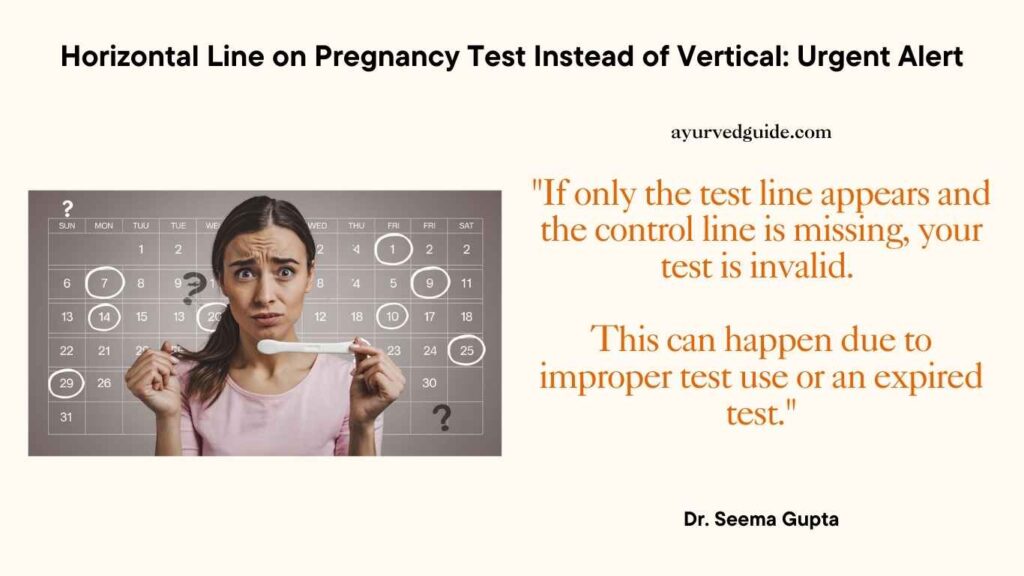
If only the T line appears on a pregnancy test and the C (control) line is missing, the test is invalid. This could happen due to an expired or defective test or improper usage. Discard the test and retake with a new one, following the instructions carefully.
Line Going Opposite Way on Pregnancy Test
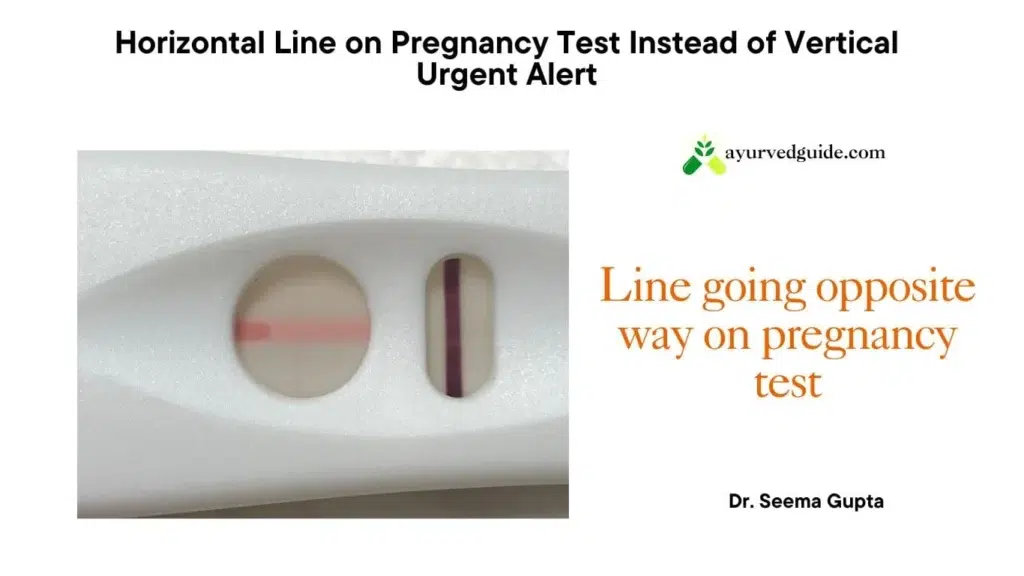
A line appearing in an unexpected direction (horizontal instead of vertical or vice versa) typically indicates:
- An invalid test result
- Improper test usage
- A need to retake the test following instructions carefully
With this understanding of what horizontal lines on pregnancy tests might mean, we’ll next explore troubleshooting these unusual results to ensure accurate pregnancy detection.
Horizontal Line on Pregnancy Test Instead of Vertical BabyCenter
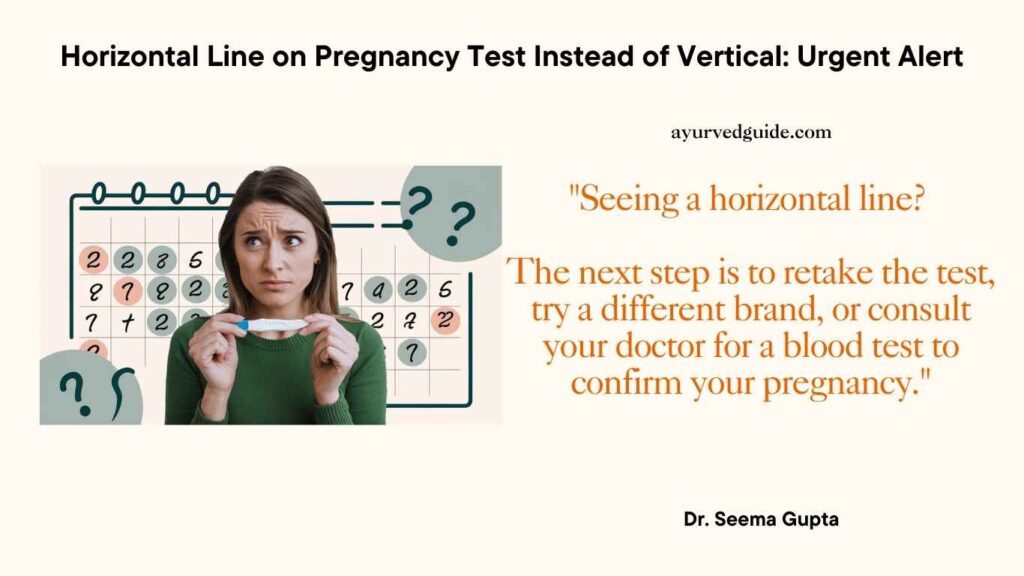
A horizontal line on a pregnancy test instead of a vertical one typically indicates a faulty test or improper usage and does not confirm pregnancy.
Clear Blue Horizontal Line Instead of Vertical – Clear Blue Pregnancy Test One Horizontal Line One Vertical
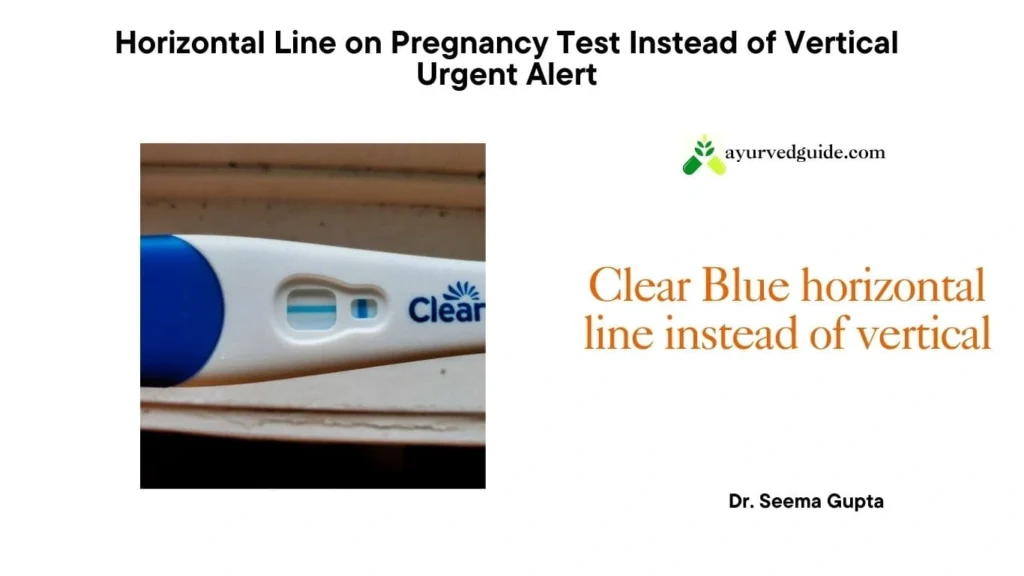
Faint horizontal line on pregnancy test
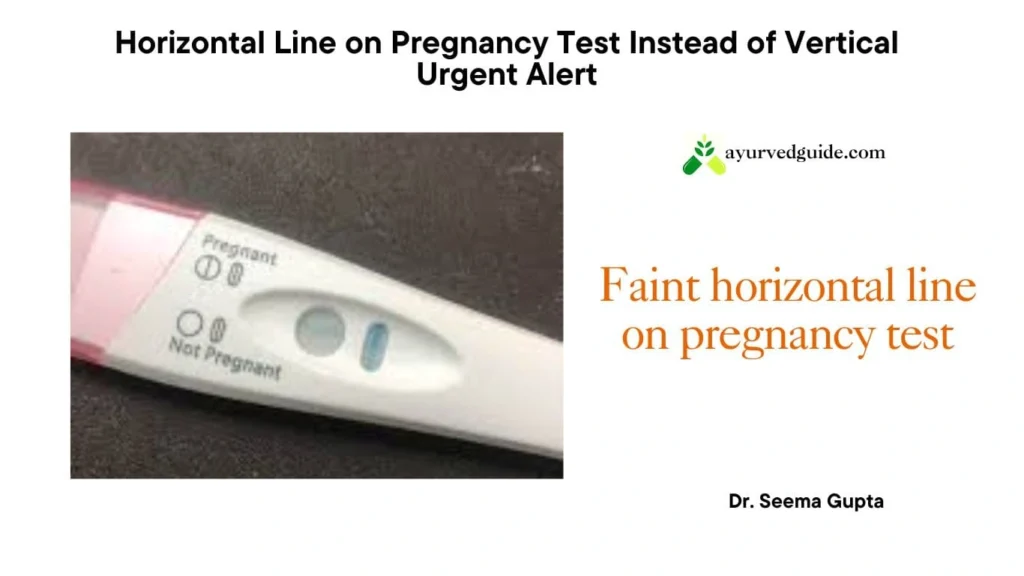
Very Faint Plus Sign On a Test That Should Not Have Any Horizontal Lines
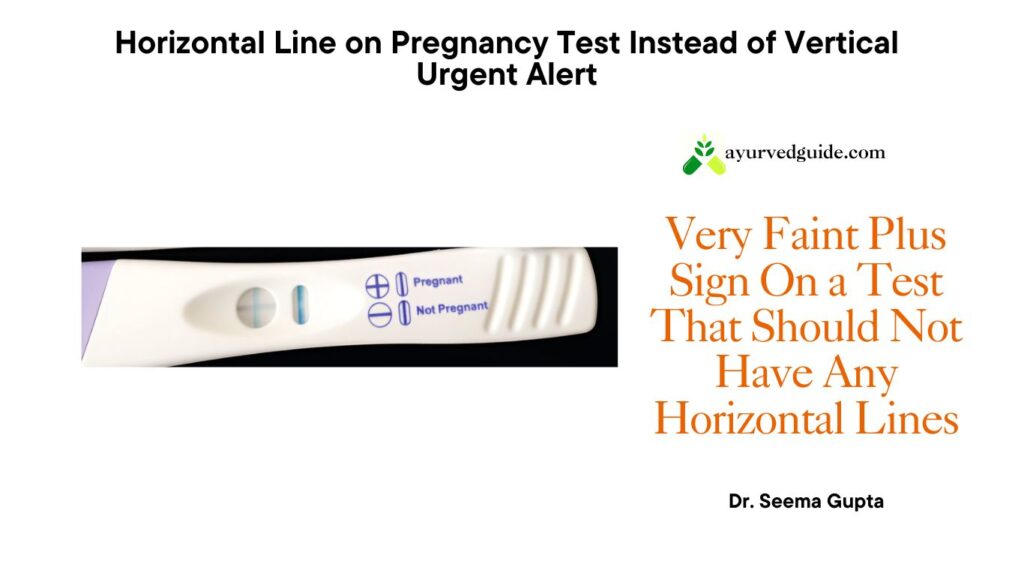
A very faint plus sign on a test that should not have horizontal lines may indicate early pregnancy or an evaporation line; confirm with another test or consult a doctor.
If period irregularities confuse you, try natural techniques like specific sleeping positions. Read about it here.
Clear Blue Two Horizontal Lines – 2 Horizontal Lines on Pregnancy Test
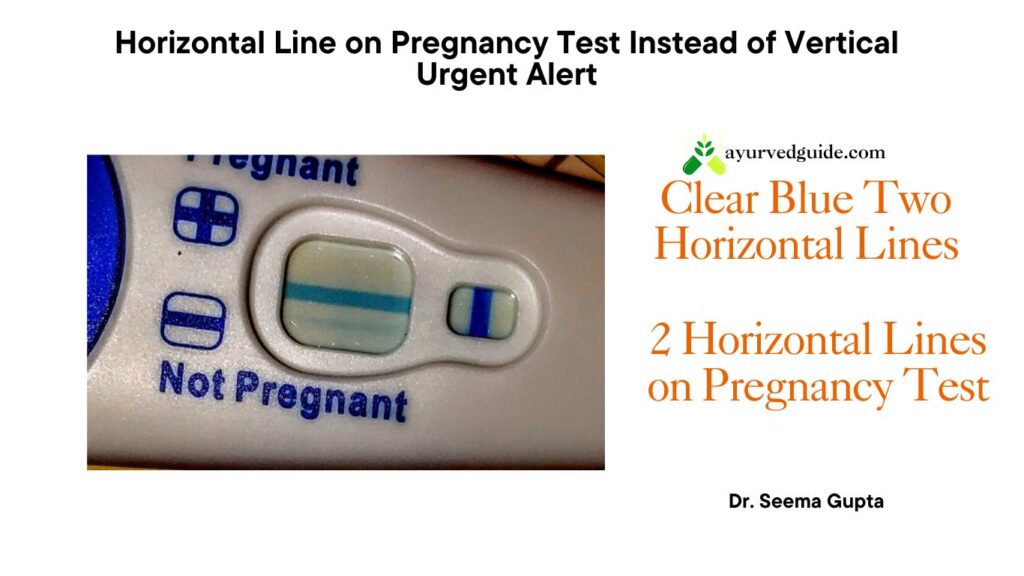
Troubleshooting Horizontal Line Results
Now that we have covered what a horizontal line on a pregnancy test means, let’s explore how to troubleshoot these results to ensure accurate testing.
Incorrect testing methods can cause errors—know what not to do before taking a pregnancy test.
A. Checking test expiration date
One of the primary reasons for unexpected horizontal lines is using an expired test. Pregnancy tests have a limited shelf life, and their effectiveness diminishes as they approach expiration. To avoid this issue:
- Always check the expiration date before use
- Discard any tests that have passed their expiration date
- Purchase tests from reputable sources to ensure freshness
B. Proper test storage and handling
Improper storage can affect the test’s reliability. To maintain test integrity:
| Storage Do’s | Storage Don’ts |
|---|---|
| Keep in a cool, dry place | Expose to extreme temperatures |
| Store in original packaging | Leave in humid environments |
| Handle with clean, dry hands | Touch the test window |
C. Following instructions accurately
Each pregnancy test brand may have specific instructions. Precise adherence to these guidelines is crucial for accurate results:
- Read the instructions thoroughly before starting
- Use the correct amount of urine as specified
- Place the test in the proper orientation
- Wait for the recommended time before reading the results
D. Timing of the test – Horizontal Line on Pregnancy Test Instead of Vertical
The timing of when you take the test can significantly impact its accuracy:
- Wait until at least the first day of a missed period for reliable results
- Use first-morning urine for optimal hCG concentration
- Avoid testing too early, which can lead to false negatives
- Consider the impact of fertility medications on test timing and results
It’s important to note that even with perfect execution, tests can sometimes yield unexpected results. Factors such as chemical pregnancies, ectopic pregnancies, or variations in individual hormone levels can affect outcomes. If you encounter persistent unusual results or have concerns, it’s advisable to consult a healthcare professional for further guidance.
With these troubleshooting steps in mind, we’ll explore the following steps to take after seeing a horizontal line on your pregnancy test.
Discover How Soon Will a Pregnancy Test Read Positive!
Next Steps After Seeing a Horizontal Line
Now that we have covered troubleshooting horizontal line results, let’s explore the next steps after encountering this situation.
A. Retaking the test
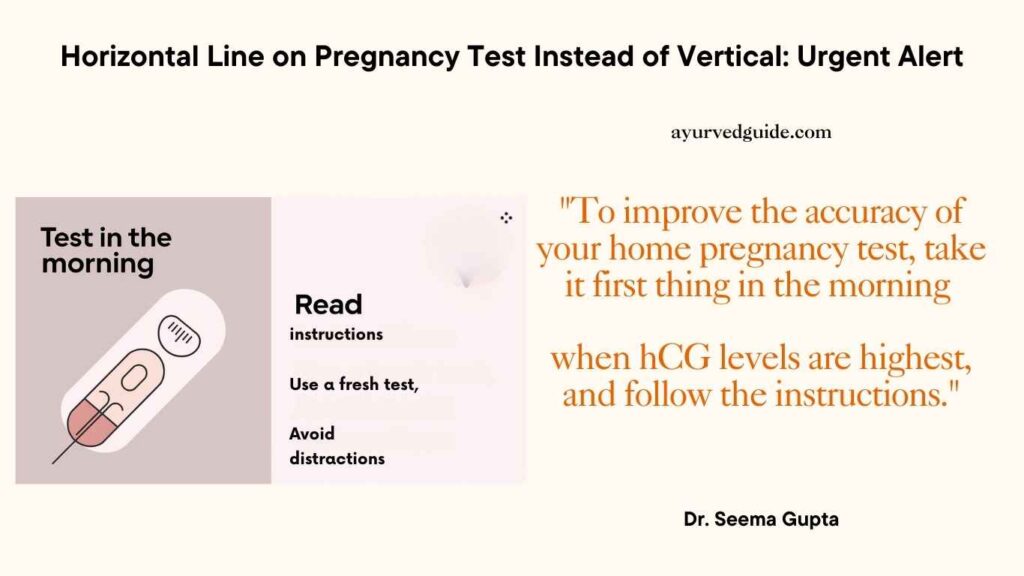
If a horizontal line appears on a pregnancy test instead of the expected vertical line, it’s crucial to retake it. This is because test results can be affected by various factors, including:
- Timing of the test
- Concentration of urine
- Test expiration date
- Test administration errors
When retaking the test, consider the following:
- Wait at least 24-48 hours before retesting
- Use the first-morning urine for higher hCG concentration
- Check the expiration date of the new test
- Carefully follow the test instructions
B. Trying a different brand of test
If retaking the test with the same brand yields inconsistent results, it may be beneficial to try a different brand. Different pregnancy tests have varying sensitivities and designs, affecting results interpretation. Consider the following when selecting a new test:
| Test Type | Advantages | Considerations |
|---|---|---|
| Digital | Clear verbal results | More expensive |
| Strip | Cost-effective | May require more interpretation |
| Two-window | Easier to read | Slightly more complex to use |
C. Consulting a healthcare professional
If uncertainty persists after retaking tests or trying different brands, it’s advisable to consult a healthcare provider. Healthcare professionals can:
- Provide guidance on proper test usage
- Offer more sensitive testing methods
- Address any underlying health concerns
D. Blood test options for pregnancy confirmation
Blood tests are available through healthcare providers for definitive results. These tests offer several advantages:
- Higher sensitivity to hCG levels
- Ability to detect pregnancy earlier than urine tests
- Quantitative results to track hCG progression
Blood tests come in two types:
- Qualitative: Determines the presence or absence of hCG
- Quantitative: Measures the exact amount of hCG in blood
Healthcare providers may recommend blood tests in cases of:
- Inconsistent home test results
- Suspected early pregnancy
- High-risk pregnancies
- Fertility treatments
With these next steps in mind, it’s important to consider ways to improve the accuracy of home pregnancy tests in the future. We will explore this in the following section, focusing on techniques to enhance result reliability and minimize confusion.
Improving Accuracy of Home Pregnancy Tests
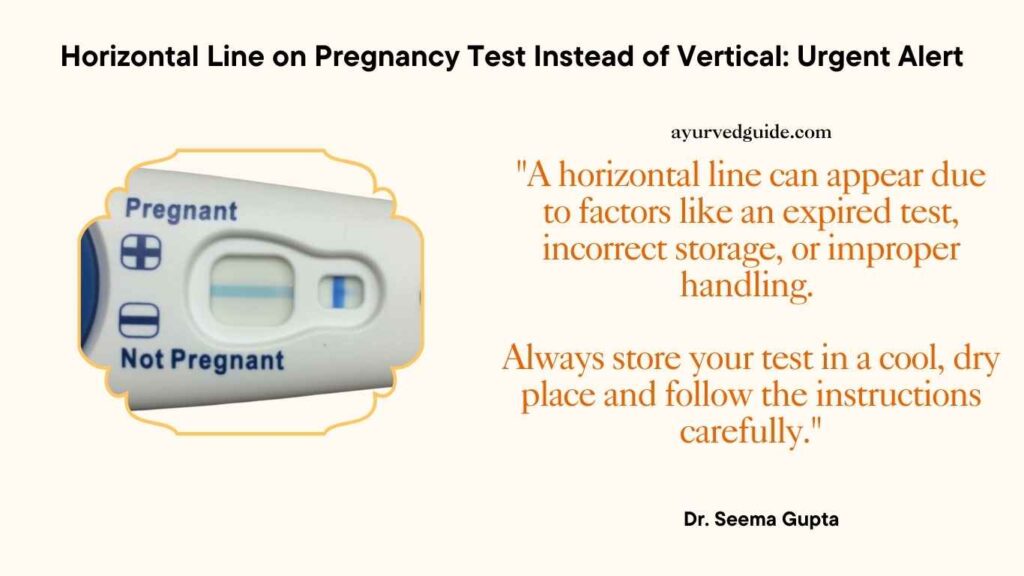
Now that we have covered the next steps after seeing a horizontal line on a pregnancy test, let’s focus on improving the accuracy of home pregnancy tests. This knowledge is crucial for obtaining reliable results and avoiding confusion.
Before panicking over unusual results, it’s important to know when to test after unprotected sex for the most accurate outcome
The best time of day to take the test
For optimal accuracy, it’s recommended to take a pregnancy test first thing in the morning. This is because:
- hCG levels in urine are highest during the first-morning void
- Concentrated urine provides more reliable results
- It minimizes the risk of false negatives due to diluted urine
Choosing the right pregnancy test
Selecting an appropriate test can significantly impact accuracy:
| Test Type | Advantages | Considerations |
|---|---|---|
| Non-digital | More sensitive to lower hCG levels | Interpretation may be subjective |
| Digital | Clear “pregnant” or “not pregnant” readout | May require higher hCG levels for accuracy |
Understanding test sensitivity levels
Test sensitivity refers to the minimum amount of hCG a test can detect:
- Lower sensitivity tests: Detect higher levels of hCG, best used after a missed period
- Higher sensitivity tests: Can detect pregnancy earlier, but may lead to false negatives if taken too soon
Avoiding common mistakes
To enhance test accuracy, avoid these common errors:
- Testing too early (before the missed period)
- Using expired tests
- Reading results outside the specified time frame
- Consuming excessive fluids before testing
- Not following instructions carefully
By adhering to these guidelines, you can significantly improve the accuracy of your home pregnancy test. Remember to check expiration dates, use the first-morning urine, and strictly follow the test instructions. If uncertainty persists or you have a history of complications, it’s advisable to seek confirmation through an ultrasound or consult with a healthcare provider.
With this improved understanding of enhancing test accuracy, you may wonder, “Why does my pregnancy test have a horizontal line?” In the next section, let’s explore this question to clarify the interpretation of pregnancy test results.
Evaporation Line vs Faint Positive – How to Decode Your Pregnancy Test Results
Why does my pregnancy test have a horizontal line?
Understanding the Horizontal Line
A horizontal line on a pregnancy test can be confusing and may lead to misinterpretation of results. This unexpected outcome typically indicates one of two scenarios:
- Test Malfunction
- Improper Test Usage
Reasons for a Horizontal Line
| Reason | Explanation |
|---|---|
| Test Malfunction | Manufacturing defect or expired test |
| Improper Usage | Not following instructions or contamination |
Common Mistakes Leading to Horizontal Lines
- Insufficient urine sample
- Reading results outside the recommended timeframe
- Exposing the test to excessive moisture or heat
Interpreting the Horizontal Line
A horizontal line alone does not indicate a positive or negative result. It’s crucial to understand that most pregnancy tests use vertical lines to show results:
- One vertical line: Negative
- Two vertical lines: Positive
If you see a horizontal line instead, the test is likely invalid and should not be interpreted as a definitive result.
Next Steps – Horizontal Line on Pregnancy Test Instead of Vertical
If you encounter a horizontal line:
- Discard the test
- Wait 24-48 hours
- Retake the test, carefully following instructions
- Consider using a different brand of test
If uncertainty persists or you experience pregnancy symptoms, consult a healthcare professional for accurate results and guidance.
What is the horizontal line on clear blue?

Understanding the Horizontal Line on Clear Blue Tests
The horizontal line on a Clear Blue pregnancy test serves as the control line, indicating that the test is functioning correctly. This line appears regardless of the test result, confirming the test’s validity.
Control Line vs. Test Line
| Line Type | Purpose | Appearance |
|---|---|---|
| Control Line | Confirms test functionality | Always horizontal |
| Test Line | Indicates the presence of the hCG hormone | Vertical (if positive) |
Interpreting Clear Blue Test Results
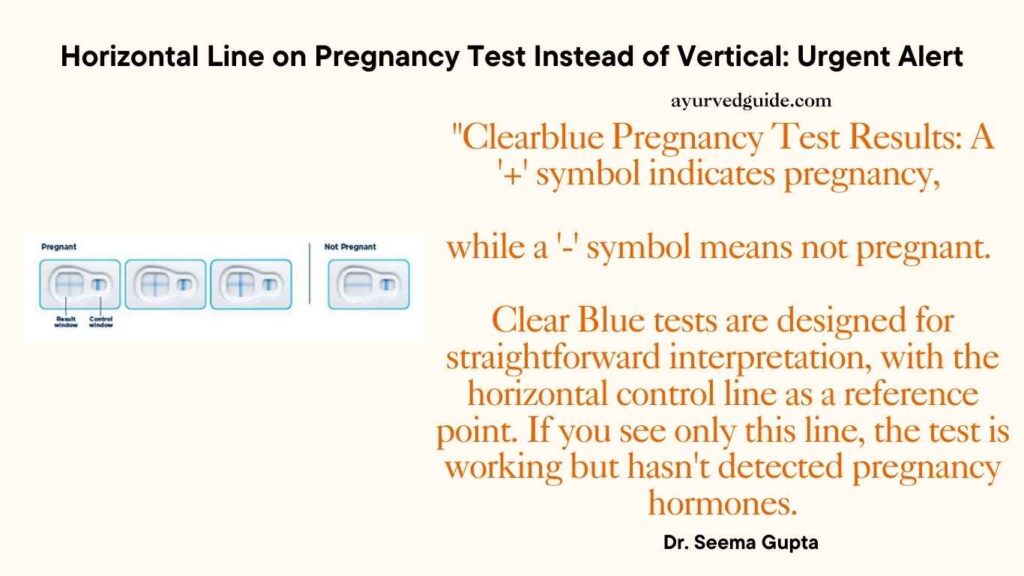
- Single horizontal line: Negative result
- Horizontal line + vertical line: Positive result
- No lines or only vertical line: Invalid test
Clear Blue tests are designed for straightforward interpretation, with the horizontal control line as a reference point. If you see only this line, the test is working but hasn’t detected pregnancy hormones. Always read the instructions carefully and wait the full recommended time before interpreting results.
Is a horizontal line positive?
![]() Interpreting a Horizontal Line on a Pregnancy Test
Interpreting a Horizontal Line on a Pregnancy Test
A horizontal line on a pregnancy test is typically not indicative of a positive result. Most home pregnancy tests are designed to show two lines for a positive result: one control line and one test line, both appearing vertically. A horizontal line may suggest:
- Test malfunction
- Improper test usage
- Evaporation line
Common Interpretations of Test Lines
| Line Appearance | Interpretation |
|---|---|
| Two vertical lines | Positive |
| One vertical line | Negative |
| Horizontal line | Invalid/Error |
| No lines | Invalid/Error |
Steps to Take After Seeing a Horizontal Line
- Carefully read the test instructions
- Retake the test with a new kit
- Wait for the recommended time before reading the results
- Consider using a digital test for clearer results
If uncertainty persists, consult a healthcare professional for a blood test or ultrasound. Remember, home pregnancy tests are most accurate when taken after a missed period and using the first-morning urine sample.
Am I pregnant? Clear blue pregnancy test, vertical line darker than horizontal. What does this mean?
Interpreting Clear Blue Pregnancy Test Results
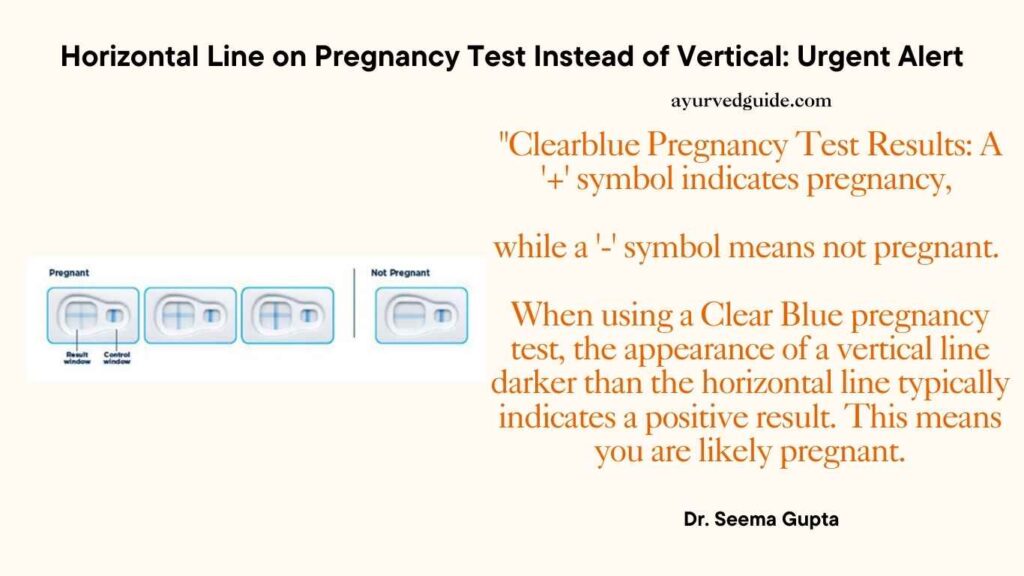
When using a Clear Blue pregnancy test, the appearance of a vertical line darker than the horizontal line typically indicates a positive result. This means you are likely pregnant. The darkness of the lines can vary, but generally, a darker vertical line suggests a higher concentration of hCG hormone in your urine.
Understanding Line Intensity
The intensity of the lines on a pregnancy test can provide additional information:
| Line Intensity | Meaning |
|---|---|
| Dark vertical, faint horizontal | Likely pregnant |
| Equal intensity | Pregnant |
| Faint vertical, dark horizontal | Possible early pregnancy or testing too early |
Factors Affecting Test Results
Several factors can influence the appearance of lines on a pregnancy test:
- Time of day when testing
- Hydration levels
- Stage of pregnancy
- Test sensitivity
It’s important to follow the instructions carefully and interpret results within the specified timeframe. If you’re unsure about the results or have concerns, it’s advisable to repeat the test in a few days or consult with a healthcare professional for confirmation.
Remember that home pregnancy tests, while generally accurate, are not infallible. A blood test conducted by a medical professional remains the most reliable method for confirming pregnancy.
Is horizontal negative or positive?
![]() Understanding Horizontal Lines on Pregnancy Tests
Understanding Horizontal Lines on Pregnancy Tests
A horizontal line on a pregnancy test can be confusing, as it doesn’t clearly indicate a positive or negative result. Generally, a horizontal line alone is not considered a positive result. Most pregnancy tests are designed to show vertical lines or symbols for positive results.
Interpreting Test Results
| Line Orientation | Typical Meaning |
|---|---|
| Vertical | Positive |
| Horizontal | Control line |
| Both | Positive |
| No lines | Invalid test |
Possible Explanations for Horizontal Lines
- The control line functioning correctly
- Test malfunction
- Improper test usage
- Evaporation line
It’s crucial to follow the test instructions precisely and check the results within the specified timeframe. If you see only a horizontal line, it’s generally advisable to:
- Wait and retest in a few days
- Use a different brand of test
- Consult with a healthcare provider for a blood test
Remember, home pregnancy tests are not 100% accurate. If you’re unsure about the results or have concerns, it’s always best to seek professional medical advice for confirmation and guidance.
What happens when a line is horizontal?
![]() Interpreting a Horizontal Line on a Pregnancy Test
Interpreting a Horizontal Line on a Pregnancy Test
When a pregnancy test displays a horizontal line instead of the expected vertical line, it typically indicates an invalid test result. This outcome can be confusing and may lead to misinterpretation of the test results.
Reasons for a Horizontal Line
- Test malfunction
- Improper test usage
- Expired test kit
- Insufficient urine sample
Impact on Test Interpretation
A horizontal line renders the test inconclusive, necessitating a retest. It’s crucial to understand that this result doesn’t confirm or deny pregnancy.
| Vertical Line | Horizontal Line | Interpretation |
|---|---|---|
| Present | Absent | Valid result |
| Absent | Present | Invalid result |
| Present | Present | Invalid result |
Next Steps
- Discard the current test
- Obtain a new test kit
- Carefully follow instructions
- Retest after 24-48 hours
- Consult the healthcare provider if uncertainty persists
Conclusion
Understanding the significance of a horizontal line helps avoid misinterpretation and ensures accurate pregnancy detection. If repeated tests show horizontal lines, it’s advisable to seek professional medical advice for a conclusive diagnosis.
Understanding pregnancy test results is crucial for those seeking clarity about their reproductive status. A horizontal line on a pregnancy test typically indicates a negative result, meaning the individual is not pregnant. This line serves as the control line, confirming that the test is functioning correctly. In contrast, a positive result is usually signified by a vertical line appearing alongside the horizontal control line, forming a “plus” sign.
For accurate results, it’s essential to follow the test instructions carefully and interpret the lines within the specified timeframe. If uncertainty persists or if there’s a strong suspicion of pregnancy despite a negative result, it’s advisable to retest after a few days or consult a healthcare professional.
Remember, home pregnancy tests are a valuable tool, but they should be used in conjunction with other indicators and medical advice for a comprehensive understanding of one’s reproductive health.
Pregnancy tests can sometimes be confusing, especially when taken after using emergency contraception. Learn how to interpret such results and how they relate to Withdrawal Bleeding After Unwanted 72 and hormonal responses.
Take our free Ayurvedic Health & Hormonal Balance Quiz to discover your body type and get personalized herbal insights.
Explore More on Pregnancy Test Confusion & Clear Guidance
Confused about pregnancy test results? Here are more helpful reads for accurate understanding:
- Evaporation Line or Faint Positive? Decode Your Test
- First 72 Hours – Early Pregnancy Signs Explained
- MTP in Biology – What It Means for Pregnancy
- Understanding Withdrawal Bleeding After Emergency Pills
- Abortion in 2025 – Ayurvedic Insight & Legal Lens
FAQ’S
Why Does My Pregnancy Test Have a Horizontal Line?
A horizontal line on a pregnancy test often indicates a faulty test, improper usage, or an evaporation line. It typically does not confirm pregnancy. Ensure you follow the instructions carefully, use a non-expired test, and consider retesting or consulting a doctor for accurate results if confusion persists.
No, a horizontal line on a pregnancy test is not considered positive. It usually indicates a faulty test, improper usage, or an evaporation line. A positive result is typically shown by vertical lines or a plus sign, depending on the test type. Retest or consult a doctor for confirmation.
If the vertical line on your Clearblue pregnancy test is darker than the horizontal, it likely indicates a positive result, as the vertical line represents pregnancy. However, ensure you followed the instructions correctly, and confirm the result with another test or consult your doctor for further clarity.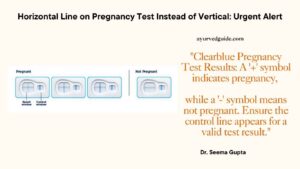
A horizontal line on a pregnancy test is generally part of the control line and does not indicate pregnancy. It is not positive or negative on its own. A positive result typically includes a vertical line or a plus sign, depending on the test design.
When a line on a pregnancy test is horizontal, it usually indicates an invalid result. This may happen due to improper usage, insufficient urine, or a faulty test. The test should ideally show vertical or clear lines for accurate results. Retaking the test with proper instructions is recommended.
On a Clearblue pregnancy test, the horizontal line is part of the control window and indicates that the test is working correctly. If no vertical line appears alongside it, the result is negative. A faint or absent control line might mean the test is invalid and should be retaken.
Dr. Seema Gupta, BAMS, MD (Naturopathy) is an Ex-House Physician in Gynecology and Obstetrics who is Advanced Certified in Diet and Nutrition. with over 27 years of experience in Women’s Health, Ayurveda, Naturopathy, and Diet, she has empowered 70,000+ patients to achieve natural healing. Her expertise in Gynecology and Obstetrics ensures personalized, science-backed advice.
